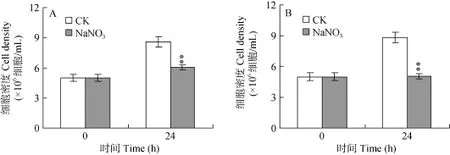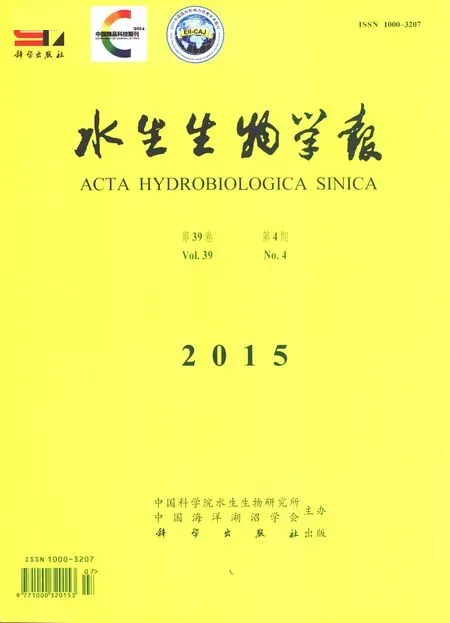NaNO3胁迫对两种微囊藻VOCs释放的影响
甘丽平 徐庆欢 杨王庭 赵静娴 周 律 张汝民 高 岩 左照江
(浙江农林大学林业与生物技术学院, 临安 311300)
NaNO3胁迫对两种微囊藻VOCs释放的影响
甘丽平 徐庆欢 杨王庭 赵静娴 周 律 张汝民 高 岩 左照江
(浙江农林大学林业与生物技术学院, 临安 311300)
为了揭示硝酸盐过量积累对藻类产生胁迫后对藻类挥发性有机化合物(VOCs)释放以及水体气味的影响, 研究以形成蓝藻水华的主要种类铜绿微囊藻和水华微囊藻为材料, 在 NaNO3胁迫下, 对其细胞生长和释放的VOCs进行测定分析。结果表明, NaNO3胁迫24h后, 铜绿微囊藻和水华微囊藻细胞生长均受到明显影响, 与对照相比细胞密度分别降低了29.6%和 43.0%。在正常条件下, 铜绿微囊藻和水华微囊藻分别释放出26和27种化合物, 其主要类型是硫化物、烃类、萜烯类、苯类、醛类和酯类化合物。在NaNO3胁迫下, VOCs含量均明显增加, 其中铜绿微囊藻释放的此6类VOCs含量分别增加了60.5%、14.3%、136.6%、92.1%、730.0% 和 120.7%, 水华微囊分别增加了 172.7%、162.5%、154.0%、55.9%、51.2%和 109.4%。此外, 铜绿微囊藻VOCs中出现4种新成分, 水华微囊藻VOCs中出现1种新成分。由此可见, 硝酸盐过量积累对藻细胞产生胁迫后会诱导其释放出大量VOCs, 从而增加水体气味、破坏水质。
细胞生长; 微囊藻; 硝酸钠; 胁迫; 挥发性有机化合物
在陆地生态系统中, 高等植物通过次生代谢途径合成并释放的挥发性有机化合物(Volatile organic compounds, VOCs)大约有30000多种[1, 2], 这些VOCs可为植食性动物侵食与病原菌侵染等生物胁迫以及高温、干旱和盐害等非生物胁迫所诱导产生[3—6], 并作为信号物质以实现其信息传递的生态功能[7—10]。
除高等植物外, 在水域生态系统中藻类植物也会产生大量 VOCs, 然而其研究报道却相对较少。Zuo等[11, 12]研究发现, 莱茵衣藻(Chlamydomonas reinhardtii)释放的 VOCs种类丰富, 其主要类型为醛类、醇类、酯类、酮类、萜烯类、烷烃类和烯烃类化合物。铜绿微囊藻(Microcystis aeruginosa)释放的VOCs主要是C15-C20脂肪族烃、臭樟脑、萜烯类、β-环柠檬醛、β-紫罗酮等化合物[13]。Huang等[14]测定鱼腥藻(Anabeana)、微囊藻、颤藻(Oscillatoria)等3种蓝藻释放到水体中的 VOCs发现, 土味素和 2-甲基异莰醇大量存在, 从而使水体呈泥土气味[15]。当采用乙酸、NaCl和Na2CO3对莱茵衣藻进行酸、碱、盐胁迫处理后, 其VOCs释放量均明显增加, 同时乙酸和NaCl胁迫还可诱导C6绿叶挥发物(Green leaves volatiles, GLVs)释放[11, 12]。由此可见, 非生物胁迫具有诱导藻类细胞释放VOCs的作用。
随着经济社会发展, 由污水排放、过量施肥渗漏、大气中氮沉降等原因造成的水体氮源含量升高并由此导致的富营养化状况已十分严峻[16—18]。在水体氮源中, 硝酸盐是其主要成分之一, 例如, 太湖水体主要以硝酸盐为主[19]。虽然水体富营养化会导致蓝藻大量生长进而破坏水质[14, 15, 20], 但是硝酸盐过量积累对藻类产生胁迫后对其VOCs释放以及水体气味有何影响, 目前尚无相关报道。因此, 本研究以形成蓝藻水华的主要种类铜绿微囊藻(M. aeruginosa)和水华微囊藻(M. flosaquae (Wittr). Kirchner)为材料, 通过分析其在NaNO3胁迫下VOCs释放与成分变化, 以期揭示硝酸盐胁迫对藻类 VOCs释放以及水体气味的影响。
1 材料与方法
1.1 实验材料
水华微囊藻 FACHB-912株系和铜绿微囊藻FACHB-1028株系均购于中国科学院水生生物研究所淡水藻种库, 此两种微囊藻均隶属于蓝藻门
(Cyanophyta)色球藻目(Chroococcales)微囊藻科(Microcystaceae)微囊藻属(Microcystis)。所用培养基均为BG11培养基(1 mol/L NaOH调节pH至 7.1),培养条件为: 温度 25 , ℃ 光照(16h)/黑暗(8h), 光强50 μmol/(m2·s), 摇床转速100 r/min。待藻细胞密度达到对数生长期时, 用于实验处理。
1.2 NaNO3胁迫处理
将处于对数生长期的微囊藻, 5000 r/min离心5min, 弃去上清, 将底部沉淀的微囊藻细胞转入含有70.4 mmol/L NaNO3(BG11标准培养基NaNO3浓度的4倍)的培养液(1 mol/L NaOH调节pH至7.1),藻细胞密度为5×106个细胞/mL。以转入BG11标准培养基(NaNO317.6 mmol/L)作为对照。3次重复。培养24h后, 对藻细胞密度及其释放的VOCs进行测定。
1.3 VOCs采集与成分分析
利用QC-2型大气采样仪(北京市劳动保护科学研究所科技发展公司)采用动态顶空套袋采集法收集微囊藻 VOCs[11, 12], 对室内空气进行采气作为空白对照。采气时间为40min, 采气流量为0.3 m3/min。
气体组分分析采用热脱附/气相色谱/质谱联用法分析(Thermal-desorption Systerm/Gas Chromatography/Mass Spectrum, TDS/GC/MS)。TDS(TDS-3型,德国Gerstel公司)工作条件: 系统载气压力为20 kpa,进样口温度为250 , ℃ 脱附温度为250 (10min),冷℃阱温度为–120 (℃ 保持3min), 冷阱进样时温度为260℃。GC (GC 7890A, 美国Agilent公司)工作条件:色谱柱为30 m×250 μm×0.25 μm的HP-5MS柱, 程序升温: 初始温度为40 , ℃ 保持4min后以6 /min℃ 的速率升至250 , ℃ 保持3min后以10 /min℃ 的速率升温到270 , ℃ 保持5min。MS (MS 5975C, 美国Agilent公司)工作条件: 电离方式为El, 电子能量为70 eV, 质量范围是28—450 aum, 接口温度280 , ℃ 离子源温度为230 , ℃ 四级杆温度为150℃。
GC/MS质量数据从 NIST/EPA/NIH 质谱库(NIST 08)中获得, 根据细胞密度计算 107个细胞释放的VOCs峰面积以表示VOCs成分的相对含量。
1.4 数据处理
实验中所测数据利用SPSS 13.0软件采用t检验进行显著性分析, 采用Origin 8.0软件进行作图。
2 结果
2.1 NaNO3胁迫对两种微囊藻细胞生长的影响
铜绿微囊藻和水华微囊藻在正常条件下培养24h后, 与初始值相比其细胞密度分别增加了71.2% 和 76.5%, 并且差异均达到极显著水平(P<0.01); 而在 NaNO3胁迫下, 细胞密度分别增加了 20.5% (P<0.01)和0.7%。在NaNO3处理24h时, 与对照相比, 两种藻细胞生长均受到明显影响, 分别降低了29.6% (P<0.01)和43.0% (P<0.01) (图1)。
2.2 NaNO3胁迫对铜绿微囊藻VOCs释放的影响

图1 NaNO3胁迫对两种微囊藻细胞生长的影响Fig. 1 The effects of NaNO3stress on the cell growth of the two Microcystis
在正常条件下, 铜绿微囊藻释放的 VOCs中含有26种化合物, 其主要成分是甲基异丙基二硫醚、异丙基(化)二硫、桉树脑、长叶烯、十五烷和丙酸-2-甲基-1-(1,1-二甲基乙基)-2-甲基-1,3-丙二基酯, 峰面积分别为7.13×106、2.26×106、3.11×106、2.60×106、2.22×106和 5.55×106/107细胞。在 NaNO3胁迫下, VOCs成分增加到28种, 其中新出现化合物4种,分别是α-蒎烯、2-乙基己醛、乙酸异辛酯和2,6,10-三甲基十四烷; 消失的化合物2种, 分别是2,4-二甲基-2,3-庚烯-5-炔和双环[4.4.1]-十一-1,3,5,7,9-五烯。除此之外, 其余各VOCs成分含量均明显增加(表1)。
铜绿微囊藻在正常条件下释放的VOCs中含有8种含氧化合物, 分别是桉树脑、1,7,7-三甲基-二环[2.2.1]庚-2-酮、环柠檬醛、2,3,5-三甲基苯甲醚、(Z)-7-十六烯醛、2,6-二叔丁基对苯醌、丙酸-2-甲基-1-(1,1-二甲基乙基)-2-甲基-1,3-丙二基酯和邻苯二甲酸二异丁酯。在NaNO3胁迫下, 除各含氧化合物含量均明显增加外, 还出现 2-乙基己醛和乙酸异辛酯2种新含氧化合物(表1)。

表1 NaNO3胁迫对铜绿微囊藻VOCs释放的影响Tab. 1 The effects of NaNO3 stress on the release VOCs from M. aeruginosa
对铜绿微囊藻 VOCs进行归类分析, 其主要类型有硫化物、烃类、萜烯类、苯类、醛类和酯类化合物。在NaNO3胁迫后, 各类化合物含量均明显增加, 与对照相比, 分别增加了 60.5%、14.3%、136.6%、92.1%、730.0%和 120.7%, 并且差异均达到极显著水平(P<0.01) (图2)。
2.3 NaNO3胁迫对水华微囊藻VOCs释放的影响
在正常条件下, 水华微囊藻释放的 VOCs中含有 27种化合物, 其主要成分是甲基异丙基二硫醚(8.15×106/107细胞)、甲基苯乙烯(1.18×106/107细胞)、异丙基(化)二硫(4.37×106/107细胞)、桉树脑(3.99×106/107细胞)、环柠檬醛(1.32×106/107细胞)和长叶烯(2.14×106/107细胞)。在NaNO3胁迫后, VOCs中出现了雪松烯 1种新成分, 同时其他各成分含量均明显增加(表2)。

图 2 NaNO3胁迫对铜绿微囊藻VOCs种类释放量的影响Fig. 2 The effects of NaNO3stress on the types of and amounts of VOCs released from M. aeruginosa

表2 NaNO3胁迫对水华微囊藻VOCs释放的影响Tab. 2 The effects of NaNO3stress on the release of VOCs from M. flos-aquae
与铜绿微囊藻相似, 水华微囊藻也会释放出含氧VOCs, 其种类为10种, 并且在NaNO3胁迫下含量均明显增加(表2)。
与铜绿微囊藻 VOCs种类相同, 水华微囊藻VOCs的种类也主要有硫化物、烃类、萜烯类、苯类、醛类和酯类化合物。在NaNO3胁迫后, 各类化合物含量分别增加了 172.7% (P<0.01)、162.5% (P<0.01)、154.0% (P<0.01)、55.9% (P<0.01)、51.2% (P<0.01)和109.4% (P<0.01) (图3)。

图 3 NaNO3胁迫对水华微囊藻VOCs种类释放量的影响Fig. 3 The effects of NaNO3stress on the types of and amounts of VOCs released types from M. flos-aquae
3 讨论
在水域生态系统中, 藻类植物可通过次生代谢途径释放大量的 VOCs, 在非生物胁迫下其释放量会明显增加。例如, 刚毛藻(Cladophora glomerata)的野外生长温度为12 , ℃ 当将其培养在23℃条件时,其释放的3种卤代烃量均明显增加[21]。采用pH 5.0乙酸处理莱茵衣藻2h, 其VOCs释放量最大、化合物种类最多[11]。采用 300 mmol/L NaCl和150 mmol/L Na2CO3处理莱茵衣藻也能诱导其释放大量的 VOCs, 但其成分间存在较大差异, 其中300 mmol/L NaCl可诱导释放 GLVs——己醛, 而150 mmol/L Na2CO3则诱导释放3,4-二甲基-己烷和5-甲基-2-庚烯等特异性成分[12]。在 NaNO3胁迫下,两种微囊藻VOCs的释放量均明显增加(图2、3), 同时铜绿微囊藻产生 4种新化合物, 水华微囊藻产生1种新化合物(表1、2)。由此可见, 非生物胁迫不仅会促进VOCs释放, 还可诱导新化合物形成。
植物体内的萜烯类化合物种类丰富, 其合成途径主要有细胞质中的甲羟戊酸途径和叶绿体中的脱氧木酮糖-5-磷酸途径[22]。在高温、盐等胁迫条件下,此合成过程的相关酶(例如: 1-脱氧-d-木酮糖-5-磷酸合成酶、1-脱氧-d-木酮糖-5-磷酸羟酸还原异构酶和异戊烯基焦磷酸酶)大量合成, 从而促进萜烯类VOCs释放[23—25]。对于含有苯环的芳香族化合物,其合成来源于苯丙氨酸[26]。例如, 水杨酸为含苯VOCs, 病原菌侵染和 O3胁迫可通过诱导相关酶基因表达而促进其释放[27]。在NaNO3胁迫下, 萜烯类和苯类化合物释放量均明显增加, 这可能与 NaNO3诱导相关合成酶基因的表达有关, 然而其具体机制尚需进行深入研究。
含硫化合物是某些植物中所特有的VOCs成分,例如芥子油甙为十字花科植物所特有, 可为昆虫取食所诱导释放[28]。两种微囊藻在NaNO3胁迫下, 甲基异丙基二硫醚和异丙基(化)二硫两种含硫化合物均大量产生, 然而其具体的形成机制尚不清楚。
在植物释放的 VOCs中, 醛、酮、醇、呋喃、有机酸、酯和氧化萜烯等均为含氧化合物[29—31]。在NaNO3胁迫下, 铜绿微囊藻和水华微囊藻的含氧VOCs释放量均明显增加, 同时铜绿微囊藻还会释放出2-乙基己醛和乙酸异辛酯2种新含氧化合物(表1、2), 这与乙酸诱导莱茵衣藻发生程序性死亡时, 其含氧VOCs释放量明显增加的研究结果相类似[32]。
研究表明, VOCs中含有不饱和键的化合物易于被活性氧(Reactive oxygen species, ROS)氧化而形成含氧化合物[32—36], 例如异戊二烯可被HO·氧化形成2-甲基呋喃[31], β-蒎烯可被O3氧化为降蒎酮[37]。盐胁迫可诱导藻细胞产生大量的 ROS, 例如 NaCl和KCl胁迫处理小球藻(Micrasterias denticulate) 5min 后, 其细胞内ROS便大量产生[38]; 20、50、100和300 mmol/L NaCl处理莱茵衣藻30min后, 其细胞内O2–.和H2O2含量均明显增加, 并且ROS含量随盐浓度增加而增加[39]。在NaNO3胁迫下, 微囊藻细胞中的ROS势必会大量产生, 这些ROS可能会参与VOCs中含氧化合物形成, 从而促进含氧VOCs释放。
由此可见, 水体中硝酸盐过量积累对藻细胞造成胁迫后会诱导其释放出大量的 VOCs, 同时胁迫诱导藻细胞产生的ROS可能会参与VOCs中含氧化合物的形成。这些藻类VOCs的大量产生势必会导致水体气味增加, 进而破坏水质。
[1] Theis N, Lerdau M. The evolution of function in plant
secondary metabolites [J]. International Journal of PlantSciences, 2003, 164(53): 93—102
[2] Maffei M E. Sites of synthesis, biochemistry and functional role of plant volatiles [J]. South African Journal of Botany, 2010, 76(4): 612—631
[3] Kost C, Heil M. The defensive role of volatile emission and extra floral nectar secretion for Lima bean in nature [J]. Journal of Chemical Ecology, 2008, 34(1): 2—13
[4] Loreto F, Schnitzler J P. Abiotic stresses and induced BVOCs [J]. Trends in Plant Science, 2009, 15(3): 154—166 [5] Kivimäenpää M, Riikonen J, Ahonen V, et al. Sensitivity of Norway spruce physiology and terpenoid emission dynamics to elevated ozone and elevated temperature under open-field exposure [J]. Environmental and Experimental Botany, 2013, 90: 32—42
[6] Copolovici L, Kännaste A, Remmel T, et al. Volatile organic compound emissions from Alnus glutinosa under interacting drought and herbivory stresses [J]. Environmental and Experimental Botany, 2014, 100: 55—63
[7] Baldwin I T, Halitschke R, Paschold A, et al. Volatile signaling in plant-plant interactions: “talking trees” in the genomics era [J]. Science, 2006, 311(5762): 812—815
[8] Bee Park H, Lee B, Kloepper J W, et al. One shot-two pathogens blocked: Exposure of Arabidopsis to hexadecane, a long chain volatile organic compound, confers induced resistance against both Pectobacterium carotovorum and Pseudomonas syringae [J]. Plant Signaling & Behavior, 2013, 8(7): e24619
[9] Zhang R, Zhang W, Zuo Z, et al. Inhibition effects of volatile organic compounds from Artemisia frigida Willd. on the pasture grass intake by lambs [J]. Small Ruminant Research, 2014, 121(2/3): 248—254
[10] Zuo Z, Zhang R, Gao P, et al. Allelopathic effects of Artemisia frigida Willd. on growth of pasture grasses in Inner Mongolia, China [J]. Biochemical Systematics and Ecology, 2011, 39(4—6): 377—383
[11] Zuo Z J, Zhu Y R, Bai Y L, et al. Volatile communication between Chlamydomonas reinhardtii cells under salt stress [J]. Biochemical Systematics and Ecology, 2012, 40: 19—24 [12] Zuo Z J, Zhu Y R, Bai Y L, et al. Acetic acid-induced programmed cell death and release of volatile organic compounds in Chlamydomonas reinhardtii [J]. Plant Physiology and Biochemistry, 2012, 51: 175—184
[13] Walsh K, Jones G J, Dunstan R H. Effect of high irradiance and iron on volatile odour compounds in the cyanobacterium Microcystis aeruginosa [J]. Phytochemistry, 1998, 49(5): 1227—1239
[14] Huang W J, Lai C H, Cheng Y L. Evaluation of extracellular products and mutagenicity in cyanobacteria cultures separated from a eutrophic reservoir [J]. Science of the Total Environment, 2007, 377(2/3): 214—223
[15] Fujise D, Tsuji K, Fukushima N, et al. Analytical aspects of cyanobacterial volatile organic compounds for investigation of their production behavior [J]. Journal of Chromatography A, 2010, 1217(39): 6122—6125
[16] Domagalski J, Lin C, Luo Y, et al. Eutrophication study at the Panjiakou-Daheiting Reservoir system, northern Hebei Province, People's Republic of China: Chlorophyll-a model and sources of phosphorus and nitrogen [J]. Agricultural Water Management, 2007, 94(1—3): 43—53
[17] Xie Y, Xiong Z, Xing G, et al. An assessment of nitrogen pollutant sources in surface water in Taihu region [J]. Pedosphere, 2007, 17(2): 200—208
[18] Bowesa M J, Smithb J T, Jarviea H P, et al. Modelling of phosphorus inputs to rivers from diffuse and point sources [J]. Science of the Total Environment, 2008, 395(2/3): 125—138
[19] Tan X, Xia X L, Cheng X L, et al. Temporal and spatial pattern of phytoplankton community and its biodiversity [J]. Environmental Science, 2011, 32(1): 2875—2882 [谭香, 夏小玲, 程晓莉, 等. 丹江口水库浮游植物群落时空动态及其多样性指数. 环境科学, 2011, 32(1): 2875—2882]
[20] Chen J L, Hu M M, Zhou H D, et al. Studies on population and the underlying impact factors of phytoplankton during the cyanobacteria bloom in lake Erhai [J]. Acta Hydrobiologica Sinica, 2015, 39(1): 24—28 [陈建良, 胡明明, 周怀东, 等. 洱海蓝藻水华暴发期浮游植物群落变化及影响因素. 水生生物学报, 2015, 39(1): 24—28]
[21] Abrahamsson K, Choo K S, Pedersén M, et al. Effects of temperature on the production of hydrogen peroxide and volatile halocarbons by brackish-water algae [J]. Phytochemistry, 2003, 64(3): 725—734
[22] Holopainen J K. Can forest trees compensate for stress-generated growth losses by induced production of volatile compounds [J]. Tree Physiology, 2011, 31(12): 1356—1377
[23] Teuber M, Zimmer I, Kreuzwieser J, et al. VOC emission of grey poplar leaves as affected by salt stress and different N sources [J]. Plant Biology, 2008, 10(1): 86—96
[24] Kivimäenpää M, Riikonen J, Ahonen V, et al. Sensitivity of Norway spruce physiology and terpenoid emission dynamics to elevated ozone and elevated temperature under open-field exposure [J]. Environmental and Experimental Botany, 2013, 90: 32—42
[25] Hartikainen K, Riikonen J, Nerg A M, et al. Impact of elevated temperature and ozone on the emission of volatile organic compounds and gas exchange of silver birch (Betula pendula Roth) [J]. Environmental and Experimental Botany, 2012, 84: 33—43
[26] Maffei M E. Sites of synthesis, biochemistry and functional role of plant volatiles [J]. South African Journal of Botany, 2010, 76(4): 612—631
[27] Schnitzler J P, Louis S, Behnke K, et al. Poplar volatiles—biosynthesis, regulation and (eco) physiology of isoprene and stress-induced isoprenoids [J]. Plant Biology, 2010, 12(2): 302—316
[28] Halkier B A, Gershenzon J. Biology and biochemistry of glucosinolates [J]. Annual Review of Plant Biology, 2006, 57: 303—333
[29] Fehsenfeld F, Calvert J, Fall R, et al. Emissions of volatile organic compounds from vegetation and the implications for atmospheric chemistry [J]. Global Biogeochemical Cycles, 1992, 6(4): 389—430
[30] Kesselmeier J, Staudt M. Biogenic volatile organic compounds (VOC): an overview on emission, physiology and ecology [J]. Journal of Atmospheric Chemistry, 1999, 33(1): 23—88
[31] Graus M, Schnitzler J P, Hansel A, et al. Transient release of oxygenated volatile organic compounds during light-dark transitions in grey poplar leaves [J]. Plant Physiology, 2004, 135(4): 1967—1975
[32] Zuo Z, Chen Z, Shi M, et al. Reactive oxygen species contribute to the release of volatile organic compounds from Chlamydomonas reinhardtii during programmed cell death [J]. Phycological Research, 2015, 63(1): 37—42
[33] Claeys M, Graham B, Vas G, et al. Formation of secondary organic aerosols through photo oxidation of isoprene [J]. Science, 2004, 303(5661): 1173—1176
[34] Arneth A, Niinemets U. Induced BVOCs: how to bug our models [J]. Trends in Plant Science, 2010, 15(3): 118—25
[35] Teruel M A, Benitez-Villalba J, Caballero N, et al. Gas-phase oxidation of methyl crotonate and ethyl crotonate. Kinetic study of their reactions toward OH radicals and Cl atoms [J]. Journal of Physical Chemistry A, 2012, 116(24): 6127—6133
[36] Lin Y H, Zhang H, Pye H O T, et al. Epoxide as a precursor to secondary organic aerosol formation from isoprene photooxidation in the presence of nitrogen oxides [J]. Proceedings of the National Academy of Sciences of the United States of America, 2013, 110(17): 6718—6723
[37] Cataldo F, Ursini O, Lilla E, et al. Ozonolysis of α-pinene, β-pinene, D and L-turpentine oil studied by chirooptical methods; some implications on the atmospheric chemistry of biogenic volatile organic compounds [J]. Ozone-Science & Engineering, 2010, 32(4): 274—285
[38] Affenzeller M J, Darehshouri A, Andosch A, et al. Salt stress-induced cell death in the unicellular green alga Micrasterias denticulate [J]. Journal of Experimental Botany, 2009, 60(3): 939—954
[39] Zuo Z, Chen Z, Zhu Y, et al. Effects of NaCl and Na2CO3stresses on photosynthetic ability of Chlamydomonas reinhardtii [J]. Biologia, 2014, 69(10): 1314—1322
THE EFFECTS OF NaNO3STRESS ON THE RELEASE OF VOCs FROM TWO MICROCYSTIS
GAN Li-Ping, XU Qing-Huan, YANG Wang-Ting, ZHAO Jing-Xian, ZHOU Lü, ZHANG Ru-Min, GAO Yan and
ZUO Zhao-Jiang
(School of Forestry and Biotechnology, Zhejiang A & F University, Lin’an 311300, China)
Nitrate is one of the major sources of pollution in water bodies. To reveal how the excessive nitrate accumulation affects the release of VOCs and causes the odor in the water, we analyzed the cell growth and VOCs from Microcystis aeruginosa and M. flosaquae--the primary species responsible for the cyanobacterial bloom--under the NaNO3stress. Compared to the control NaNO3significantly reduced the cell growth of M. aeruginosa and M. flos-aquae by 29.6% and 43.0% respectively after the 24h stress. Under the normal condition, M. aeruginosa and M. flosaquae released 26 and 27 compounds respectively, and the major types of VOCs were sulphide, hydrocarbons, terpenoids, benzenes, aldehydes and esters. In M. aeruginosa the release of these 6 VOCs was remarkably increased by 60.5%, 14.3%, 136.6%, 92.1%, 730.0% and 120.7% respectively after the NaNO3treatment, and the increments in M. flos-aquae were 172.7%, 162.5%, 154.0%, 55.9%, 51.2% and 109.4% respectively. In addition, 4 new compounds were found in VOCs of M. aeruginosa under the NaNO3stress, and 1 new compound was found in VOCs of M. flosaquae. Therefore, the stress of excessive nitrate accumulation on algae may promote the release of VOCs, which could aggravate the odor and the quality of the water.
Cell growth; Microcystis; NaNO3; Stress; Volatile organic compounds
Q142
A
1000-3207(2015)04-0782-07
10.7541/2015.102
2014-12-29;
2015-03-06
国家自然科学青年基金项目(31300364); 浙江农林大学科研发展基金人才启动项目(2013FR069)资助
甘丽平(1993—), 女, 贵州贵定人; 学士; 主要从事藻类VOCs研究。E-mail: 1095252032@qq.com
左照江, E-mail: zuozhaojiang@126.com

